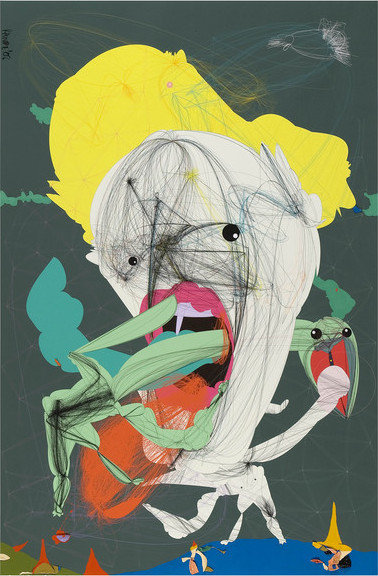Alexis Kersey, Aditya Pande and Maurizio Vetrugno
dal 25/6/2008 al 22/8/2008
Segnalato da
25/6/2008
Alexis Kersey, Aditya Pande and Maurizio Vetrugno
Alexia Goethe Gallery, London
All three artists share an infatuation with the visual idioms of popular culture, a chromatic sophistication, a puckish wit, and the connoisseurship of craftsmanship. Exhibition in collaboration with Gallery Nature Morte.

The Alexia Goethe Gallery is proud to present this first collaboration with Gallery Nature Morte, showcasing the works of Alexis Kersey, Aditya Pande and Maurizio Vetrugno.
While survey shows of contemporary art from India continue to be popular fare among the major museums of the world (with little sign of this trend abating) and private galleries now jumping into the action, the arena for “Contemporary Indian Art” has experienced a manifold expansion during this decade. Markets, like museums, prefer well-wrapped packages with tidy contents, facilitating both quick consumption and easy understanding. However limitations can be not only insulting but also a form of violence. How do we define artistic production as it occurs in various places: by the skin colour of its maker, by the influences acknowledged by the artist, by nationality, or by stylistic traits? What does today’s world want from an “Indian contemporary art” and how do we understand such a moniker? The only legitimate response would be to further complicate its parameters, so as to do justice to that which it might be asked to attempt to “represent.” Unfortunately, the place where art is made and the nationality of its creators are the most convenient hooks to toss curatorial hats on to in these busy times. But the peripatetic pendulums of influence rarely pay attention to national, geographical or historical sign-posts; dreams and ideas rarely carry passports or require visas. Our present exhibition features art created by one Indian, one Anglo-Indian, and one Italian. All three share an infatuation with the visual idioms of popular culture, a chromatic sophistication, a puckish wit, and the connoisseurship of craftsmanship. All three choose to turn a blind eye to the status (or lack thereof) attributed to various visual languages and artisanal materials, performing a perfectly Post-Modern ménage within a globalised scenario. Peter Nagy
Aditya Pande was born in Lucknow, raised in Chandigarh, trained at the National Institute of Design in Ahmedabad, and currently lives in New Delhi. His studio production oscillates between the fine and applied arts, two and three dimensions, the sensuously tactile and the aggressively optical. On the computer, Pande weaves a tangled web of synthetic line work, looping through grand arabesques and squiggling together skeins to form animals and people. These forms are anchored by bold blocks of skewed colors, usually applied with glossy enamel paints that contrast against the more powdery finish of the ink-jet print, sometimes further articulated by the appearance of an unblinking eyeball or a shiny nose. On occasion collage elements are mixed in, for a pleasingly demented farce that is the collusion of painting, print-making, graphic design and draftsmanship.
Alexis Kersey hails from a British family that has resided in the southern Indian city of Mysore for three generations. His childhood was spent in both India and the U.K. while his training in art was anti-institutional and at the squatted knees of commercial sign painters on the pavements of Madras (now rechristened Chennai). A cartoonish vulgarity has been his trademark for a number of years, having established himself with an invented iconography that posited the mystical Indian seer against his more militaristic countrymen or innocent children against insidiously commercialized trends (Hare Krishna Punks, Company School Junkies, Yogic Nuclear Missiles, Spiritualized Sex Slaves, and the like). Kersey’s more recent works have tempered their icons with a confluence of materials: oil painting backgrounds are affixed with inlaid-wood panels, mirrors and enameled glass, framed with carved and painted flourishes. In these works, images, materials and techniques fuse to a theatrical finish, burgeoning on to a perversely decorative amplitude.
Maurizio Vetrugno is from Turin, Italy. Only an occasional visitor to India, he is a part-time resident of Bali, whose Hindu culture migrated there centuries ago from India. In his work he has long been interested in the interstitial spaces between cultural productions of various calibers: art, fashion, music, celebrity, publicity and iconography. In a group of works produced to be shown in New Delhi (and now being exhibited in London), Vetrugno recreates the images used to package popular music as hand-embroidered panels of silk (created with craftsmen in Laos). His focus is on Indian imagery as it has been used by both Indian musicians themselves for an international market and by Western musicians to communicate their ideals. Vetrugno’s “couture” uses images from the 1950s up to today to trace both the conscious and naïve permutations “Indianess” has been subjected to.
Opening june 26, 2008
Alexia Goethe Gallery
7 Dover Street - London



